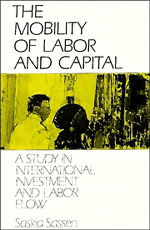Book contents
- Frontmatter
- Contents
- List of tables
- Acknowledgements
- Introduction
- 1 Foreign investment: a neglected variable
- 2 The use of foreign workers
- 3 The new immigration
- 4 The globalization of production: implications for labor migration
- 5 The rise of global cities and the new labor demand
- 6 The reconcentration of capital in the United States: a new investment zone?
- Conclusion
- Notes
- References
- Index
1 - Foreign investment: a neglected variable
Published online by Cambridge University Press: 04 April 2011
- Frontmatter
- Contents
- List of tables
- Acknowledgements
- Introduction
- 1 Foreign investment: a neglected variable
- 2 The use of foreign workers
- 3 The new immigration
- 4 The globalization of production: implications for labor migration
- 5 The rise of global cities and the new labor demand
- 6 The reconcentration of capital in the United States: a new investment zone?
- Conclusion
- Notes
- References
- Index
Summary
There is considerable evidence both on international labor migrations and on the internationalization of production. But they are mostly two separate bodies of scholarship. Analytically these two processes have been constructed into unrelated categories. As socioeconomic givens, there are certain locations where one can identify the presence of both. Our question then becomes whether there is an articulation between these two processes and, if so, how we can capture this analytically. Furthermore, the notion of the internationalization of production needs to be elaborated in order to incorporate more of its central components. Theoretical and empirical studies of this process have focused largely on one particular component: the massive shift of jobs to Third World countries through direct foreign investment, resulting in the development of an off-shore manufacturing sector.
The question about the articulation of these two processes stems from both a broader theoretical argument on the nature of the world economy and from the concrete details of the new migrations to the U.S. Similarly, the need to elaborate the notion of the internationalization of production stems from that broader theoretical argument as well as from the concrete details of the U.S. economy over the last twenty years. In this chapter I briefly review the main conceptual and empirical lines of analysis that bring these various concerns together.
- Type
- Chapter
- Information
- The Mobility of Labor and CapitalA Study in International Investment and Labor Flow, pp. 12 - 25Publisher: Cambridge University PressPrint publication year: 1988
- 6
- Cited by



